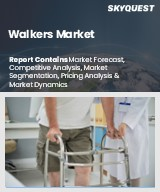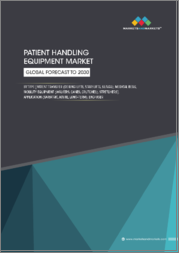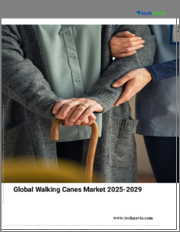
|
시장보고서
상품코드
1599365
보행 보조 기기 시장 : 제품, 기술, 연령, 유통 채널, 최종사용자별 - 세계 예측(2025-2030년)Walking Assist Devices Market by Product (Cane, Crutches, Gait Belts), Technology (Manual, Powered/Assistive), Age, Distribution Channel, End-User - Global Forecast 2025-2030 |
||||||
보행 보조 기기 시장은 2023년 33억 8,000만 달러로 평가되며 2024년에는 36억 5,000만 달러에 달할 것으로 예상되며, 연평균 6.96% 성장하여 2030년에는 54억 2,000만 달러에 달할 것으로 예측됩니다.
보행 보조 기기에는 보행 장애가 있는 사람들이 효율적으로 걷거나 이동할 수 있도록 돕기 위해 고안된 다양한 도구가 포함됩니다. 이러한 도구에는 지팡이, 목발, 보행기, 전동 스쿠터 등이 포함됩니다. 보행 보조 기기의 필요성은 주로 고령화, 근골격계 장애 증가, 이동 장애로 이어지는 사고 증가로 인해 발생합니다. 재활센터, 병원, 재택 요양 환경, 노인 및 소아 전문 요양원 등 다양한 용도로 사용됩니다. 최종 용도에는 일시적인 장애, 만성질환, 노화로 인한 이동 문제가 있는 사람들이 포함됩니다.
| 주요 시장 통계 | |
|---|---|
| 기준 연도(2023년) | 33억 8,000만 달러 |
| 예측 연도(2024년) | 36억 5,000만 달러 |
| 예측 연도(2030년) | 54억 2,000만 달러 |
| CAGR(%) | 6.96% |
시장 성장은 모빌리티 기기에 IoT 통합, 헬스케어 인프라에 대한 투자 증가, 장애인 지원에 대한 인식 증가와 같은 기술 발전에 크게 영향을 받을 것으로 보입니다. 또한, 맞춤형 보조 기기에 대한 수요 증가와 E-Commerce 헬스케어 플랫폼의 확대도 큰 성장 기회로 작용할 것으로 보입니다. 이러한 잠재적 비즈니스 기회를 활용하기 위해서는 기술 통합을 통한 제품 다양화, 유통 채널 강화, 의료 서비스 제공업체와의 전략적 파트너십 구축 등에 집중해야 합니다.
그러나 시장 개척은 첨단 장비의 높은 비용, 규제 문제, 신흥국 지역에서의 낮은 인지도 등의 요인으로 인해 제한을 받고 있습니다. 또한, 보험 환급 문제, 장비 피팅 및 교육을 담당할 숙련된 전문가 부족 등의 문제에 직면해 있습니다. 기술 혁신이 필요한 분야로는 내구성이 높고 비용 효율적인 솔루션 개발, 사용자 친화적인 디자인 강화, 지속가능한 재료 탐색 등이 있습니다. 또한 인터페이스와 사용자 분석을 개선하기 위해 인공지능을 통합하는 연구도 가능합니다.
시장 경쟁은 치열해지고 있지만, 혁신과 고객 지향적 솔루션으로 차별화를 통해 성장할 수 있는 여건이 조성되어 있습니다. 지속적인 모니터링과 헬스케어 규제에 대한 적응, 소비자 피드백은 큰 시장 점유율을 확보하고 최종사용자의 진화하는 요구에 부응하고자 하는 기업에게 매우 중요합니다.
시장 역학 : 빠르게 진화하는 보행 보조 기기 시장의 주요 시장 인사이트 파악
보행 보조 기기 시장은 수요 및 공급의 역동적인 상호작용에 의해 변화하고 있습니다. 이러한 시장 역학의 진화를 이해함으로써 기업은 정보에 입각한 투자 결정을 내리고, 전략적 의사결정을 정교화하며, 새로운 비즈니스 기회를 포착할 수 있습니다. 이러한 트렌드를 종합적으로 파악함으로써 기업은 정치적, 지리적, 기술적, 사회적, 경제적 영역 전반에 걸친 다양한 리스크를 줄일 수 있으며, 소비자 행동과 그것이 제조 비용 및 구매 동향에 미치는 영향을 보다 명확하게 이해할 수 있습니다.
- 시장 성장 촉진요인
- 인구구조의 변화와 노인 인구 증가
- 운동 기능 장애 및 장애 발생률 증가
- 부상 및 수술 후 재활환자를 위한 보행보조기구에 대한 수요 증가
- 시장 성장 억제요인
- 보행 보조 기기의 높은 가격과 제한된 접근성
- 시장 기회
- 보행 보조 기기의 스마트 센서와 고도 제어 시스템 통합
- 사용 편의성을 향상시키는 어시스트 디바이스 경량화 소재 개발
- 시장 과제
- 기술의 복잡성 및 제한된 작동 지원 범위
Porter's Five Forces : 보행 보조 기기 시장 공략을 위한 전략 도구
Porter's Five Forces 프레임워크는 시장 상황의 경쟁 구도를 이해하는 중요한 도구입니다. Porter's Five Forces 프레임워크는 기업의 경쟁력을 평가하고 전략적 기회를 탐색할 수 있는 명확한 방법을 제공합니다. 이 프레임워크는 기업이 시장 내 세력도를 평가하고 신규 사업의 수익성을 판단하는 데 도움이 됩니다. 이러한 인사이트를 통해 기업은 강점을 활용하고, 약점을 해결하고, 잠재적인 도전을 피하고, 보다 강력한 시장 포지셔닝을 확보할 수 있습니다.
PESTLE 분석 : 보행보조기구 시장의 외부 영향 파악
외부 거시 환경 요인은 보행 보조 기기 시장의 성과 역학을 형성하는 데 매우 중요한 역할을 합니다. 정치적, 경제적, 사회적, 기술적, 법적, 환경적 요인에 대한 분석은 이러한 영향을 탐색하는 데 필요한 정보를 제공하며, PESTLE 요인을 조사함으로써 기업은 잠재적 위험과 기회를 더 잘 이해할 수 있습니다. 이러한 분석을 통해 기업은 규제, 소비자 선호도, 경제 동향의 변화를 예측하고 선제적이고 능동적인 의사결정을 내릴 준비를 할 수 있습니다.
시장 점유율 분석 : 보행보조기기 시장에서의 경쟁 상황 파악
보행 보조 기기 시장의 상세한 시장 점유율 분석을 통해 공급업체의 성과를 종합적으로 평가할 수 있습니다. 기업은 수익, 고객 기반, 성장률과 같은 주요 지표를 비교하여 경쟁적 위치를 파악할 수 있습니다. 이 분석은 시장의 집중화, 단편화, 통합의 추세를 파악할 수 있으며, 공급업체는 치열한 경쟁 속에서 자신의 입지를 강화할 수 있는 전략적 의사결정을 내리는 데 필요한 인사이트를 얻을 수 있습니다.
FPNV 포지셔닝 매트릭스 : 보행 보조 기기 시장에서의 벤더 성과 평가
FPNV 포지셔닝 매트릭스는 보행 보조 기기 시장에서 벤더를 평가하는 중요한 도구입니다. 이 매트릭스를 통해 비즈니스 조직은 벤더의 비즈니스 전략과 제품 만족도를 기반으로 평가하여 목표에 부합하는 정보에 입각한 의사결정을 내릴 수 있으며, 4개의 사분면으로 벤더를 명확하고 정확하게 세분화하여 전략 목표에 가장 적합한 파트너와 솔루션을 식별할 수 있습니다. 전략 목표에 가장 적합한 파트너와 솔루션을 식별할 수 있습니다.
보행보조기구 시장에서의 성공 전략 분석 및 추천 보행보조기구 시장에서의 성공 경로를 그립니다.
보행 보조 기기 시장 전략 분석은 세계 시장에서 입지를 강화하고자 하는 기업에게 필수적입니다. 주요 자원, 역량 및 성과 지표를 검토함으로써 기업은 성장 기회를 식별하고 개선할 수 있습니다. 이러한 접근 방식을 통해 경쟁 환경의 도전을 극복하고 새로운 비즈니스 기회를 활용하여 장기적인 성공을 거둘 수 있도록 준비할 수 있습니다.
이 보고서는 주요 관심 분야를 포괄하는 시장에 대한 종합적인 분석을 제공합니다.
1. 시장 침투도 : 현재 시장 환경의 상세한 검토, 주요 기업의 광범위한 데이터, 시장 도달 범위 및 전반적인 영향력 평가.
2. 시장 개척도 : 신흥 시장에서의 성장 기회를 파악하고, 기존 분야의 확장 가능성을 평가하며, 미래 성장을 위한 전략적 로드맵을 제공합니다.
3. 시장 다각화 : 최근 제품 출시, 미개척 지역, 업계의 주요 발전, 시장을 형성하는 전략적 투자를 분석합니다.
4. 경쟁 평가 및 정보 : 경쟁 구도를 철저히 분석하여 시장 점유율, 사업 전략, 제품 포트폴리오, 인증, 규제 당국의 승인, 특허 동향, 주요 기업의 기술 발전 등을 검토합니다.
5. 제품 개발 및 혁신 : 향후 시장 성장을 가속할 것으로 예상되는 첨단 기술, 연구 개발 활동 및 제품 혁신을 강조합니다.
이해관계자들이 충분한 정보를 바탕으로 의사결정을 내릴 수 있도록 다음과 같은 중요한 질문에 대한 답변도 제공합니다.
1. 현재 시장 규모와 향후 성장 전망은?
2. 최고의 투자 기회를 제공하는 제품, 부문, 지역은?
3. 시장을 형성하는 주요 기술 동향과 규제의 영향은?
4. 주요 벤더 시장 점유율과 경쟁 포지션은?
5. 벤더 시장 진입 및 철수 전략의 원동력이 되는 수익원과 전략적 기회는 무엇인가?
목차
제1장 서문
제2장 조사 방법
제3장 주요 요약
제4장 시장 개요
제5장 시장 인사이트
- 시장 역학
- 성장 촉진요인
- 성장 억제요인
- 기회
- 과제
- 시장 세분화 분석
- Porter's Five Forces 분석
- PESTEL 분석
- 정치
- 경제
- 사회
- 기술
- 법률
- 환경
제6장 보행 보조 기기 시장 : 제품별
- 지팡이
- 목발
- 보행 벨트
- 워커
- 휠체어
제7장 보행 보조 기기 시장 : 기술별
- 수동
- 전동/보조
제8장 보행 보조 기기 시장 : 연령별
- 성인
- 노인
- 소아
제9장 보행 보조 기기 시장 : 유통 채널별
- 오프라인
- 온라인
제10장 보행 보조 기기 시장 : 최종사용자별
- 고령자 간병 시설
- 홈케어 설정
- 병원·클리닉
- 스포츠 & 재활 센터
제11장 아메리카의 보행 보조 기기 시장
- 아르헨티나
- 브라질
- 캐나다
- 멕시코
- 미국
제12장 아시아태평양의 보행 보조 기기 시장
- 호주
- 중국
- 인도
- 인도네시아
- 일본
- 말레이시아
- 필리핀
- 싱가포르
- 한국
- 대만
- 태국
- 베트남
제13장 유럽, 중동 및 아프리카의 보행 보조 기기 시장
- 덴마크
- 이집트
- 핀란드
- 프랑스
- 독일
- 이스라엘
- 이탈리아
- 네덜란드
- 나이지리아
- 노르웨이
- 폴란드
- 카타르
- 러시아
- 사우디아라비아
- 남아프리카공화국
- 스페인
- 스웨덴
- 스위스
- 터키
- 아랍에미리트
- 영국
제14장 경쟁 상황
- 시장 점유율 분석 2023
- FPNV 포지셔닝 매트릭스, 2023
- 경쟁 시나리오 분석
- 전략 분석과 제안
기업 리스트
- Aetna Inc.
- Besco Medical Co., Ltd.
- Biobase Group
- Comfort Orthopedic Co., Ltd.
- De Oro Devices
- Drive DeVilbiss Healthcare
- Electric Mobility Euro Ltd.
- GF Health Products Inc.
- Guangzhou Yeecon Medical Equipment Industrial Co., Ltd.
- Handicare Group
- Honda Motor Co., Ltd.
- Invacare Corporation.
- Karma Healthcare Ltd.
- Levo AG
- MEYRA GmbH
- Ningbo Jinhong Medical Instrument Co., Ltd.
- Ossenberg GmbH
- Otto Bock Australia Pty. Ltd.
- Permobil Inc
- Pride Mobility Products Corporation
- ReWalk Robotics Ltd.
- RxFunction, Inc.
- Shenzhen Zuowei Technology Co., Ltd.
- Sunrise Medical(US) LLC
- Synetik ErgoCare
- Yattil Industry Co., Ltd.
The Walking Assist Devices Market was valued at USD 3.38 billion in 2023, expected to reach USD 3.65 billion in 2024, and is projected to grow at a CAGR of 6.96%, to USD 5.42 billion by 2030.
Walking assist devices encompass a broad range of tools designed to aid individuals with mobility impairments, enhancing their ability to walk or move effectively. These tools can include canes, crutches, walkers, and power scooters, among others. The necessity for walking assist devices is primarily driven by the aging population, rising incidences of musculoskeletal disorders, and increased cases of accidents leading to mobility challenges. Applications span across rehabilitation centers, hospitals, home care settings, and specialized geriatric and pediatric care units. End-use scope includes individuals with temporary disabilities, chronic conditions, or age-related mobility issues.
| KEY MARKET STATISTICS | |
|---|---|
| Base Year [2023] | USD 3.38 billion |
| Estimated Year [2024] | USD 3.65 billion |
| Forecast Year [2030] | USD 5.42 billion |
| CAGR (%) | 6.96% |
Market growth is significantly influenced by technological advancements such as integration of IoT in mobility devices, increasing investments in healthcare infrastructure, and rising awareness about disability assistance. Additionally, growing demand for personalized assist devices and the expansion of e-commerce healthcare platforms provide substantial growth opportunities. Recommendations for tapping into these potential opportunities include focusing on product diversification through technology integration, enhancing distribution channels, and forming strategic partnerships with healthcare providers.
However, market expansion is constrained by factors such as high costs of advanced devices, regulatory challenges, and limited awareness in developing regions. Moreover, the market faces challenges related to reimbursement issues and a shortage of skilled professionals for device fitting and training. Areas ripe for innovation include developing cost-effective solutions with higher durability, enhancing user-friendly designs, and exploring sustainable materials. There is also potential for research in integrating artificial intelligence for improved interface and user analytics.
The nature of the walking assist devices market is competitive yet poised for growth, differentiated by innovation and customer-focused solutions. Continuous monitoring and adaptation to healthcare regulations, coupled with consumer feedback, will be crucial for companies aiming to capture significant market share and meet the evolving needs of end users.
Market Dynamics: Unveiling Key Market Insights in the Rapidly Evolving Walking Assist Devices Market
The Walking Assist Devices Market is undergoing transformative changes driven by a dynamic interplay of supply and demand factors. Understanding these evolving market dynamics prepares business organizations to make informed investment decisions, refine strategic decisions, and seize new opportunities. By gaining a comprehensive view of these trends, business organizations can mitigate various risks across political, geographic, technical, social, and economic domains while also gaining a clearer understanding of consumer behavior and its impact on manufacturing costs and purchasing trends.
- Market Drivers
- Changing demographics and rise in the elderly population
- Increasing incidence of mobility impairments and disorder
- Rising demand for walking assist devices for patients in post-injury or post-surgery rehabilitation
- Market Restraints
- High cost and limited accessibility of walking assist devices
- Market Opportunities
- Integration of smart sensors and advanced control systems in walking assist devices
- Development of lightweight materials in making assist devices to enhance usability
- Market Challenges
- Technological complexity and limited range of motion support
Porter's Five Forces: A Strategic Tool for Navigating the Walking Assist Devices Market
Porter's five forces framework is a critical tool for understanding the competitive landscape of the Walking Assist Devices Market. It offers business organizations with a clear methodology for evaluating their competitive positioning and exploring strategic opportunities. This framework helps businesses assess the power dynamics within the market and determine the profitability of new ventures. With these insights, business organizations can leverage their strengths, address weaknesses, and avoid potential challenges, ensuring a more resilient market positioning.
PESTLE Analysis: Navigating External Influences in the Walking Assist Devices Market
External macro-environmental factors play a pivotal role in shaping the performance dynamics of the Walking Assist Devices Market. Political, Economic, Social, Technological, Legal, and Environmental factors analysis provides the necessary information to navigate these influences. By examining PESTLE factors, businesses can better understand potential risks and opportunities. This analysis enables business organizations to anticipate changes in regulations, consumer preferences, and economic trends, ensuring they are prepared to make proactive, forward-thinking decisions.
Market Share Analysis: Understanding the Competitive Landscape in the Walking Assist Devices Market
A detailed market share analysis in the Walking Assist Devices Market provides a comprehensive assessment of vendors' performance. Companies can identify their competitive positioning by comparing key metrics, including revenue, customer base, and growth rates. This analysis highlights market concentration, fragmentation, and trends in consolidation, offering vendors the insights required to make strategic decisions that enhance their position in an increasingly competitive landscape.
FPNV Positioning Matrix: Evaluating Vendors' Performance in the Walking Assist Devices Market
The Forefront, Pathfinder, Niche, Vital (FPNV) Positioning Matrix is a critical tool for evaluating vendors within the Walking Assist Devices Market. This matrix enables business organizations to make well-informed decisions that align with their goals by assessing vendors based on their business strategy and product satisfaction. The four quadrants provide a clear and precise segmentation of vendors, helping users identify the right partners and solutions that best fit their strategic objectives.
Strategy Analysis & Recommendation: Charting a Path to Success in the Walking Assist Devices Market
A strategic analysis of the Walking Assist Devices Market is essential for businesses looking to strengthen their global market presence. By reviewing key resources, capabilities, and performance indicators, business organizations can identify growth opportunities and work toward improvement. This approach helps businesses navigate challenges in the competitive landscape and ensures they are well-positioned to capitalize on newer opportunities and drive long-term success.
Key Company Profiles
The report delves into recent significant developments in the Walking Assist Devices Market, highlighting leading vendors and their innovative profiles. These include Aetna Inc., Besco Medical Co., Ltd., Biobase Group, Comfort Orthopedic Co., Ltd., De Oro Devices, Drive DeVilbiss Healthcare, Electric Mobility Euro Ltd., GF Health Products Inc., Guangzhou Yeecon Medical Equipment Industrial Co., Ltd., Handicare Group, Honda Motor Co., Ltd., Invacare Corporation., Karma Healthcare Ltd., Levo AG, MEYRA GmbH, Ningbo Jinhong Medical Instrument Co., Ltd., Ossenberg GmbH, Otto Bock Australia Pty. Ltd., Permobil Inc, Pride Mobility Products Corporation, ReWalk Robotics Ltd., RxFunction, Inc., Shenzhen Zuowei Technology Co., Ltd., Sunrise Medical (US) LLC, Synetik ErgoCare, and Yattil Industry Co., Ltd..
Market Segmentation & Coverage
This research report categorizes the Walking Assist Devices Market to forecast the revenues and analyze trends in each of the following sub-markets:
- Based on Product, market is studied across Cane, Crutches, Gait Belts, Walkers, and Wheel Chair.
- Based on Technology, market is studied across Manual and Powered/Assistive.
- Based on Age, market is studied across Adult, Geriatric, and Pediatric.
- Based on Distribution Channel, market is studied across Offline and Online.
- Based on End-User, market is studied across Elderly Care Facilities, Home Care Settings, Hospitals & Clinics, and Sports & Rehabilitation Centers.
- Based on Region, market is studied across Americas, Asia-Pacific, and Europe, Middle East & Africa. The Americas is further studied across Argentina, Brazil, Canada, Mexico, and United States. The United States is further studied across California, Florida, Illinois, New York, Ohio, Pennsylvania, and Texas. The Asia-Pacific is further studied across Australia, China, India, Indonesia, Japan, Malaysia, Philippines, Singapore, South Korea, Taiwan, Thailand, and Vietnam. The Europe, Middle East & Africa is further studied across Denmark, Egypt, Finland, France, Germany, Israel, Italy, Netherlands, Nigeria, Norway, Poland, Qatar, Russia, Saudi Arabia, South Africa, Spain, Sweden, Switzerland, Turkey, United Arab Emirates, and United Kingdom.
The report offers a comprehensive analysis of the market, covering key focus areas:
1. Market Penetration: A detailed review of the current market environment, including extensive data from top industry players, evaluating their market reach and overall influence.
2. Market Development: Identifies growth opportunities in emerging markets and assesses expansion potential in established sectors, providing a strategic roadmap for future growth.
3. Market Diversification: Analyzes recent product launches, untapped geographic regions, major industry advancements, and strategic investments reshaping the market.
4. Competitive Assessment & Intelligence: Provides a thorough analysis of the competitive landscape, examining market share, business strategies, product portfolios, certifications, regulatory approvals, patent trends, and technological advancements of key players.
5. Product Development & Innovation: Highlights cutting-edge technologies, R&D activities, and product innovations expected to drive future market growth.
The report also answers critical questions to aid stakeholders in making informed decisions:
1. What is the current market size, and what is the forecasted growth?
2. Which products, segments, and regions offer the best investment opportunities?
3. What are the key technology trends and regulatory influences shaping the market?
4. How do leading vendors rank in terms of market share and competitive positioning?
5. What revenue sources and strategic opportunities drive vendors' market entry or exit strategies?
Table of Contents
1. Preface
- 1.1. Objectives of the Study
- 1.2. Market Segmentation & Coverage
- 1.3. Years Considered for the Study
- 1.4. Currency & Pricing
- 1.5. Language
- 1.6. Stakeholders
2. Research Methodology
- 2.1. Define: Research Objective
- 2.2. Determine: Research Design
- 2.3. Prepare: Research Instrument
- 2.4. Collect: Data Source
- 2.5. Analyze: Data Interpretation
- 2.6. Formulate: Data Verification
- 2.7. Publish: Research Report
- 2.8. Repeat: Report Update
3. Executive Summary
4. Market Overview
5. Market Insights
- 5.1. Market Dynamics
- 5.1.1. Drivers
- 5.1.1.1. Changing demographics and rise in the elderly population
- 5.1.1.2. Increasing incidence of mobility impairments and disorder
- 5.1.1.3. Rising demand for walking assist devices for patients in post-injury or post-surgery rehabilitation
- 5.1.2. Restraints
- 5.1.2.1. High cost and limited accessibility of walking assist devices
- 5.1.3. Opportunities
- 5.1.3.1. Integration of smart sensors and advanced control systems in walking assist devices
- 5.1.3.2. Development of lightweight materials in making assist devices to enhance usability
- 5.1.4. Challenges
- 5.1.4.1. Technological complexity and limited range of motion support
- 5.1.1. Drivers
- 5.2. Market Segmentation Analysis
- 5.3. Porter's Five Forces Analysis
- 5.3.1. Threat of New Entrants
- 5.3.2. Threat of Substitutes
- 5.3.3. Bargaining Power of Customers
- 5.3.4. Bargaining Power of Suppliers
- 5.3.5. Industry Rivalry
- 5.4. PESTLE Analysis
- 5.4.1. Political
- 5.4.2. Economic
- 5.4.3. Social
- 5.4.4. Technological
- 5.4.5. Legal
- 5.4.6. Environmental
6. Walking Assist Devices Market, by Product
- 6.1. Introduction
- 6.2. Cane
- 6.3. Crutches
- 6.4. Gait Belts
- 6.5. Walkers
- 6.6. Wheel Chair
7. Walking Assist Devices Market, by Technology
- 7.1. Introduction
- 7.2. Manual
- 7.3. Powered/Assistive
8. Walking Assist Devices Market, by Age
- 8.1. Introduction
- 8.2. Adult
- 8.3. Geriatric
- 8.4. Pediatric
9. Walking Assist Devices Market, by Distribution Channel
- 9.1. Introduction
- 9.2. Offline
- 9.3. Online
10. Walking Assist Devices Market, by End-User
- 10.1. Introduction
- 10.2. Elderly Care Facilities
- 10.3. Home Care Settings
- 10.4. Hospitals & Clinics
- 10.5. Sports & Rehabilitation Centers
11. Americas Walking Assist Devices Market
- 11.1. Introduction
- 11.2. Argentina
- 11.3. Brazil
- 11.4. Canada
- 11.5. Mexico
- 11.6. United States
12. Asia-Pacific Walking Assist Devices Market
- 12.1. Introduction
- 12.2. Australia
- 12.3. China
- 12.4. India
- 12.5. Indonesia
- 12.6. Japan
- 12.7. Malaysia
- 12.8. Philippines
- 12.9. Singapore
- 12.10. South Korea
- 12.11. Taiwan
- 12.12. Thailand
- 12.13. Vietnam
13. Europe, Middle East & Africa Walking Assist Devices Market
- 13.1. Introduction
- 13.2. Denmark
- 13.3. Egypt
- 13.4. Finland
- 13.5. France
- 13.6. Germany
- 13.7. Israel
- 13.8. Italy
- 13.9. Netherlands
- 13.10. Nigeria
- 13.11. Norway
- 13.12. Poland
- 13.13. Qatar
- 13.14. Russia
- 13.15. Saudi Arabia
- 13.16. South Africa
- 13.17. Spain
- 13.18. Sweden
- 13.19. Switzerland
- 13.20. Turkey
- 13.21. United Arab Emirates
- 13.22. United Kingdom
14. Competitive Landscape
- 14.1. Market Share Analysis, 2023
- 14.2. FPNV Positioning Matrix, 2023
- 14.3. Competitive Scenario Analysis
- 14.4. Strategy Analysis & Recommendation
Companies Mentioned
- 1. Aetna Inc.
- 2. Besco Medical Co., Ltd.
- 3. Biobase Group
- 4. Comfort Orthopedic Co., Ltd.
- 5. De Oro Devices
- 6. Drive DeVilbiss Healthcare
- 7. Electric Mobility Euro Ltd.
- 8. GF Health Products Inc.
- 9. Guangzhou Yeecon Medical Equipment Industrial Co., Ltd.
- 10. Handicare Group
- 11. Honda Motor Co., Ltd.
- 12. Invacare Corporation.
- 13. Karma Healthcare Ltd.
- 14. Levo AG
- 15. MEYRA GmbH
- 16. Ningbo Jinhong Medical Instrument Co., Ltd.
- 17. Ossenberg GmbH
- 18. Otto Bock Australia Pty. Ltd.
- 19. Permobil Inc
- 20. Pride Mobility Products Corporation
- 21. ReWalk Robotics Ltd.
- 22. RxFunction, Inc.
- 23. Shenzhen Zuowei Technology Co., Ltd.
- 24. Sunrise Medical (US) LLC
- 25. Synetik ErgoCare
- 26. Yattil Industry Co., Ltd.



















